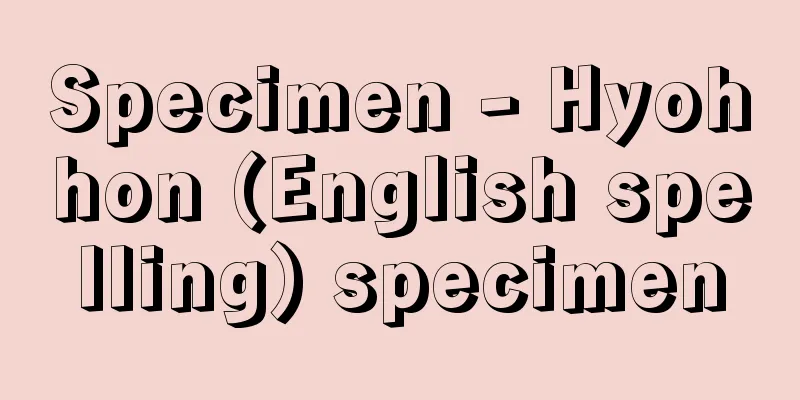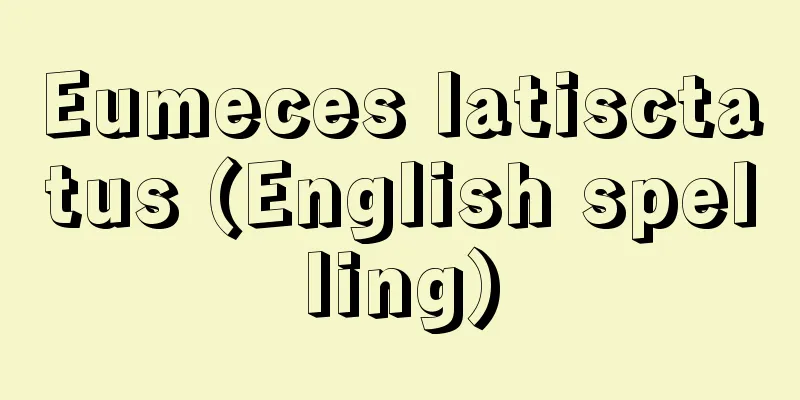Specimen - Hyohhon (English spelling) specimen

|
This refers to organisms or minerals preserved for research or educational purposes in zoology, botany, medicine, mineralogy, etc. Rocks, minerals, and fossils can be preserved for a long time as is, but organisms require treatment for preservation. Specimens differ from models in that they contain not only described traits, but also many traits that have yet to be described. Properly preserved specimens can be examined repeatedly whenever necessary, making them indispensable research materials for identifying species, etc., and for this reason, specimens for research must be preserved for a long time. Universities and museums around the country are responsible for this task. Specimens for education are used as displays and teaching materials, and are required to attract the interest of viewers. There are many different types of specimens, but this article will focus on animal and plant specimens. The history of specimen preservation in Japan is still quite short compared to Europe and the U.S. Taking pressed plant specimens as an example, major Japanese universities and museums preserve around 500,000 specimens, while the National Museum of Natural History in Paris preserves around 5 million specimens, ten times as many. [Makoto Yoshida] Specimen classification and preparationSpecimens are broadly divided into dried specimens, liquid-preserved (immersion) specimens, and slides. A dried specimen is made by removing water from the tissues of an organism through drying. Dry specimens include dried specimens, which are made by drying the organism as is, as well as stuffed specimens and frozen specimens. A liquid specimen is made by immersing an organism in a concentrated liquid to remove water from its tissues or to increase the concentration of body fluids in the tissues. There are two types of liquid specimens: alcohol and formalin. [Makoto Yoshida] Dried specimen(1) Pressed specimens Pressed specimens are the most common type of plant specimen, and are essential materials for plant classification and research. After removing a collected plant from its container or plastic bag, it is first sandwiched between newspaper. The standard size is the same as a folded page of newspaper (40 cm x 27 cm). This is called "paper clippings." On the paper clippings, the collection location, date, collector, etc. are written in oil-based ink. The most important step in making a pressed specimen is to clip the plant between the paper clips. Spread the plant out as carefully as possible on the paper clippings, stretching any broken leaves and stems, and clipping larger ones so that they fit within the size of the paper clippings. Some of the leaves are turned face down so that both sides can be observed. To aid in the removal of water from the plant matter, absorbent paper is inserted between the sandwiches. The stacked plants are then held down by thick boards (pressing boards) on top and bottom, and weights are placed on top of them. The size of the pressing boards should be slightly larger than the paper used for the binding. Do not stack too many, at most about 20 centimeters. The weights should be in the shape of a board, but ordinary stones can also be used. Leave the paper used for the binding and replace the absorbent paper twice a day for the first one or two days, once a day for the next four days, and every other day thereafter. Commercially available absorbent paper is good, but several layers of newspaper can also be used. If newspaper is used, however, mark the paper with oil-based ink or similar to avoid confusing it with the paper used for the binding. Be careful not to stack the absorbent paper too thickly, as this can cause the plants to become steamy in the summer and be ruined. It has also become common to dry plants in a dryer without using weights. After 2 to 3 weeks, when the leaves and stems are taut, attach the dried plant to the mount. The mount should be a folded page of newspaper, or slightly larger. First, place the specimen on the mount and carefully determine its position so that it does not protrude beyond the edge of the mount. First, secure the roots and stem with a paper band, then secure the part of the specimen near the tip, and then the leaves and branches. The band should be high-quality Japanese paper, coated with gum arabic. Ordinary starch paste is not suitable as it can be eaten by insects. Cellophane tape is also not suitable for long-term storage. A label with the name of the specimen (scientific name and Japanese name), collection location, collection date, and collector should be affixed to the bottom right of the mount with the specimen attached. (2) Dried specimens of moss and seaweed Moss and other plants are not pressed, but the soil is removed, dried, and then wrapped in paper for preservation. In the case of seaweed, specimens in liquid are better for research purposes, but pressed specimens are often used. However, seaweed contains a large amount of salt and water, and special techniques are required for processing. (3) Stuffed specimens: Used for specimens of mammals, birds, reptiles, amphibians, fish, etc. These specimens are made by removing the skin, flesh and internal organs, and filling them with stuffing to give them a shape. Temporary stuffed specimens are used for research purposes, while permanent stuffed specimens are used for educational purposes. The skin is tanned and the inside of the skin is rubbed with burnt alum to prevent the hair from falling out or changing. A permanent stuffed specimen needs to look the same as when the animal was alive, which requires advanced techniques such as how to insert the core (stuffing). Cores can be made from cotton, plaster, or glass fiber. Glass prosthetic eyes are inserted into the eyes, and cores are also inserted into the ears. For animals with short hair and exposed skin, even the muscles and blood vessels must be made to look the same as when the animal was alive. This is not necessary for temporary specimens. For mammals, an incision is made in the abdomen and the skin is removed. Next, cotton is stuffed inside to give the animal a shape, and the skin is sewn together and left to dry. (4) Freeze-dried specimens This is a method in which the air pressure is reduced while the organism is frozen, and the moisture is removed and the organism is dried. This makes it possible to make specimens of small vertebrates, insect larvae, flowers, and other organisms that are difficult to make specimens of using normal drying methods. (5) Dried specimens: Specimens that have been naturally dried and are used for insects, crustaceans, shellfish, etc. In the case of insects, wings and legs are often spread. To spread wings, first insert an insect needle of an appropriate thickness according to the size of the insect (there are sizes from 1 to 6, the higher the number the thicker it is) into the center of the thorax, slightly to the right of the center, and fix the insect's body in the groove in the center of the spreading board so that it is parallel to the left and right. Then, make sure that the rear ends of the forewings (the front ends of the hind wings in the case of dragonflies) are in a straight line from left to right. The wings are held down with thin paper tape and secured with a needle. Next, the antennae are neatly shaped. Once wings spreading is complete, the insect is placed together with the spreading board in a large box containing insect repellent and left to dry. After about two weeks of drying, the spreading board is removed and the insect is transferred to a specimen box. It is best to spread the wings on the same day it is collected. For insects that have hardened over the course of days, place a petri dish or similar on water-soaked cotton, place the insect wrapped in triangular paper on top, cover, and leave for 2-3 days to soften. Add a small amount of cresol or similar to prevent mold growth. As the abdomen of grasshoppers rots easily, it is cut open, the internal organs are removed, and cotton is stuffed into it to give it shape. For dragonflies, the digestive tract is removed and pine leaves or similar are inserted to prevent the body from breaking. For rhinoceros beetles and grasshoppers, they are attached to a foot board with insect needles, with their legs and antennae extended. For very small insects, they are attached to a mount (a thick white material such as a business card is best) and the mount is secured in place with a needle. Another method is to secure the insect with a very thin needle and then pierce it into the mount. Dragonflies are large and take up a lot of space, so they may not be spread out and may be stored wrapped in triangular paper. In this case, the feces of the collected dragonfly are removed, a core is inserted into the body, and the body is wrapped in triangular paper for storage. Crustaceans are easy to prepare specimens of because they are enclosed in a hard shell. First, remove the internal organs with tweezers, wash them with water, and reshape them. Next, fix the specimen on a board with a needle. Then, soak it in 10% formalin for 2-3 days and dry it in the shade. In the case of shellfish, first remove the meat. Put the shellfish in a pot of water, heat it for a short time, and while it is still warm, remove the meat with a needle or tweezers. It is difficult to remove the meat from small snails using this method, so it may be necessary to wait until the shellfish has rotted before removing it. It is also better to make dried specimens of turtlenecks, starfish, sea urchins, and sponges. [Makoto Yoshida] Liquid specimenThere are two types of preservation: alcohol preservation and formalin preservation. For alcohol preservation, a 70-80% alcohol solution is usually used, while for formalin preservation, a 5-10% formalin solution is usually used. Each method has its advantages and disadvantages, so it is necessary to choose the appropriate method according to the type of specimen. Since alcohol is neutral, it is suitable for preserving animals with calcareous skin or skeletons. It also does not make the specimen hard and brittle, as formalin does. However, because it has excellent solvent properties, it can dissolve the pigments in the specimen, causing significant decolorization. It also evaporates easily. If you are not careful, the preservation solution may run out. It is also more expensive than formalin. Formalin does not promote decolorization very much, and has a great ability to fix biological tissues. However, it has the disadvantage of making the specimen hard and brittle. In addition, it evaporates easily and produces a toxic gas (formic acid). Formic acid dissolves calcareous matter, so it is not suitable for preserving calcareous animals. Both alcohol and formalin evaporate, so check the amount from time to time, and replenish the liquid if it is low. Also, if the liquid becomes cloudy after a few days of putting the specimen in, replace the liquid. A wide-mouth glass bottle is recommended as the specimen bottle. A fixative is made by first fixing the organism and then placing the fixed organism in a preservative. For some organisms the fixative is the preservative itself (alcohol or formalin), but for many invertebrates the fixative is different. Fixatives include Fleming's fixative, Schaudhin's fixative, Gilson's fixative, Bouin's fixative, and Carnoy's fixative. The methods for fixation and preservation of each animal are described below. (1) Porifera It is best to fix and preserve the entire specimen in 80% alcohol, but because this is expensive, it is easier to preserve part of the specimen in alcohol and the rest in dry form. Denatured alcohol and formalin are unsuitable because they dissolve the calcareous matter in sponges. (2) Coelenterates: It is not good to prepare specimens with shrunken bodies. Fix them by suddenly pouring in 40% formalin or saturated mercury chloride solution. Another method is to anesthetize them with menthol. This will result in specimens with elongated bodies. Those fixed with mercury chloride should be thoroughly washed with water and stored in 5-10% formalin or 70% alcohol. (3) Annelids Polychaetes are anesthetized with menthol or similar, then fixed and preserved in 80% alcohol or 5% formalin. Oligochaetes such as earthworms are placed in water and anesthetized by gradually pouring in 70% alcohol. The anesthetized specimens are fixed in 10% formalin and then preserved in 5% formalin or 70% alcohol. (4) Arthropods Daphnia should be fixed overnight in 5% formalin, then thoroughly washed and preserved in 70% alcohol. Formic acid from formalin dissolves the shells of daphnia, so it is necessary to neutralize the solution with sodium bicarbonate. Crayfish and barnacles should be fixed and preserved in 70% alcohol or 3-5% neutral formalin. Shrimp should be fixed and preserved in 70% alcohol. Large shrimp can be dried. Crabs can be fixed and preserved in the same way as shrimp. If they are preserved in 5-10% neutral formalin for 2-3 months and then transferred to 70% alcohol, the original color will be well preserved. Arachnids (scorpions, whip scorpions, crabs, harvestmen, spiders) should be fixed and preserved in 70% alcohol. Since the alcohol can evaporate and dry up, it is recommended to double-soak them. (5) Molluscs: Shellfish are fixed in 25% alcohol, transferred to 50% alcohol after 1-2 days, and then transferred to 75% alcohol after a few days. Cephalopods are fixed in 5% formalin, transferred to 70% alcohol after 1-2 days, and then transferred to 70% alcohol for storage. (6) Echinoderms: Sea lilies and starfish are fixed and preserved in 85% alcohol. Sea urchins contain a large amount of water in their bodies, so they are first immersed in 95% alcohol and then transferred to 80% alcohol. Sea cucumbers may spit out their internal organs when excited, so they are thoroughly anesthetized with menthol or other liquids before being fixed in 80% alcohol. [Makoto Yoshida] PreparationSmall animals are difficult to observe when preserved in liquid or dried specimens, so they are often prepared as slides. First, they are fixed in a fixative, stained with carmine or other stains, and then prepared as slides. [Makoto Yoshida] Preservation of specimensSpecimens are essential for taxonomy. The specimen used to name a species or subspecies is called the "type specimen," and the holotype is the only specimen that serves as the basis for identifying a species or subspecies. Specimens for research must be labeled with information such as the collector, collection site, scientific name, Japanese name, collection date, and specimen number. Dried specimens are usually stored in a specimen chest, and specimens in liquid are usually stored in a specimen cupboard or shelf. The order of storage should follow natural classification, first dividing the specimens into families, and then arranging the genera and species in alphabetical order within each family. A specimen ledger should be created so that the order in which the specimens are stored can be seen at a glance. The room in which the specimens are kept should be a place with low temperature and humidity, with little change in temperature and humidity. It is important to put insecticide and insect repellent in the specimen boxes, and to prevent the specimens from discoloring or losing color, to store them in a case that is not exposed to sunlight. [Makoto Yoshida] "Makino's New Plant Illustrated Guide" edited by Makino Tomitaro (1972, Hokuryukan)" ▽ "Ecology and Observation of Soil Animals" edited by Watanabe Hiroyuki (1973, Tsukiji Shokan)" ▽ "Ecology and Observation of Freshwater Organisms" edited by Mizuno Toshihiko (1977, Tsukiji Shokan)" ▽ "Standard Color Illustrated Guide 3: Shellfish" by Namibe Tadashige and Kosuge Sadao (1978, Hoikusha)" ▽ "How to Collect Insects and Make Specimens" by Aoki Ryo and Hashimoto Kenichi (1979, New Science)" ▽ "Entomology Guide" by Nomura Kenichi (1980, New Science)" ▽ "Collection and Specimens" by Fujimoto Kazuyuki (1980, Hoikusha)" ▽ "Makino Tomitaro, Makino Plant Encyclopedia" and "Makino Plant Encyclopedia - Sequel" edited by Honda Masatsugu (1982, 1983, Hokuryukan)" ▽ "Freshwater Phytoplankton" edited by Fukushima Hiroshi (1983, New Science Publishing)" ▽ "Japanese Freshwater Plankton Encyclopedia" revised edition by Mizuno Toshihiko (1984, Hoikusha Publishing)" ▽ "Japanese Spider Encyclopedia" edited by Yaginuma Takeo (1986, Hoikusha Publishing)" ▽ "Kyoto Mushroom Encyclopedia" by Yoshimi Shoichi and Takayama Sakae (1990, Kyoto Shimbun Publishing)" ▽ "Cicadas and Grasshoppers" edited by Miyatake Yorio and Kano Yasutsugu (1992, Hoikusha Publishing)" ▽ "Umino Kazuo, Tsutsui Manabu and photographs "Catching Insects, Raising Insects, Making Specimens" (1998, Kaiseisha Publishing)" ▽ "Sea Animals" by Kazuyuki Fujimoto (1999, Hoikusha)" ▽ "Illustrated Guide to Freshwater Zooplankton of Japan" edited by Toshihiko Mizuno and Eiji Takahashi (2000, Tokai University Press)" ▽ "Makino Tomitaro, Ono Mikio et al., Makino's New Illustrated Guide to Japanese Plants" (2000, Hokuryukan) [References] | | | | | | | | | | | | | | | | animals| |©Shogakukan "> Preparation of specimens by biological group Source: Shogakukan Encyclopedia Nipponica About Encyclopedia Nipponica Information | Legend |
|
動物学や植物学、医学、鉱物学などで研究用または教育用に保存される生物や鉱物をいう。岩石、鉱物、化石などはそのままで長く保存できるが、生物の場合は保存のための処理を必要とする。 標本には、記載された形質だけでなく、まだ記載されていない多くの形質が含まれている点で、模型とは異なる。適切に保存された標本は、必要なときに何度でも繰り返して調査できるので、種名の同定などの研究資料として欠くことのできないものであり、そのため研究用の標本は長く保存されなければならない。各地の大学や博物館がその任にあたっている。教育用の標本は展示や教材として使われるもので、見る者の関心をひくようなものであることが求められる。標本は多種多様にあるが、この項目では動物と植物の標本を中心に述べる。 日本の標本保存の歴史はヨーロッパやアメリカに比べるとまだ日が浅い。植物の押し葉標本を例にとってみると、日本の主要な大学や博物館が保存している標本は約50万点であるが、パリの国立自然史博物館のそれは約500万点であり、10倍の標本数がある。 [吉田 真] 標本の分類と製法標本は、乾燥標本と液漬(えきし)(液浸(えきしん))標本およびプレパラートに大別される。 乾燥標本は、乾燥によって生物体の組織から水分を除去してつくられる。乾燥標本には、生物体をそのまま乾燥させる乾製標本のほかに、剥製(はくせい)標本や凍結標本が含まれる。 液漬標本は、生物体を高濃度の液体に漬けてその組織に含まれる水分を除去するか、組織中の体液の濃度を高めることによってつくられる。液漬標本には、アルコール漬けとホルマリン漬けの2種類がある。 [吉田 真] 乾燥標本(1)押し葉標本 押し葉標本は植物標本のもっとも一般的なものであり、植物の分類や研究に欠かせない資料である。採集した植物を胴乱(どうらん)やビニル袋から出して、まず新聞紙に挟む。新聞紙1ページの二つ折りの大きさ(40センチメートル×27センチメートル)が標準的なものである。これを「挟み紙」という。挟み紙には、採集場所、年月日、採集者などを油性インキで記入しておく。この挟み紙に植物を挟み込む作業が押し葉標本の作成においてもっとも重要である。植物をできるだけていねいに挟み紙の上に広げ、折れた葉や茎をよく伸ばし、大きなものは挟み紙の大きさに入るように挟んでいく。葉の何枚かは裏向きにして、表と裏の観察ができるようにする。 植物体からの水分の除去を進めるために、挟み紙と挟み紙の間に吸水紙を挿入する。 こうして順次積み重ねたものの上下を厚い板(押し板)で押さえ、その上に重石(おもし)を置く。押し板の大きさは挟み紙より一回り大きなものがよい。あまり多く積み重ねず、せいぜい20センチメートルぐらいがよい。重石は板状のものがよいが、普通の石でもよい。挟み紙はそのままにして、吸水紙を最初の1~2日は毎日2回、その後の4日間は毎日1回、それ以後は隔日に取り替える。吸水紙は市販のものがよいが、新聞紙を数枚重ねたものでもよい。ただし新聞紙を使う場合は、挟み紙と混同しないように、挟み紙に油性インキなどで目印をつけておく。吸水紙をあまり厚く重ねると、夏には植物が蒸れてだめになることもあるので注意を要する。なお、重石を使わずに乾燥機で乾燥させることも多くなった。 2~3週間後、葉や茎がぴんと張ったぐらいまでに乾燥した植物を台紙に張り付ける。台紙は新聞紙1ページの二つ折り、またはそれよりわずかに大きいものを用いる。まず標本を台紙にのせ、台紙からはみださないよう注意して位置を決める。最初に根や茎を帯紙(おびがみ)で留め、次に標本の先端部に近い部分を留め、それから葉や枝を留める。帯紙は上質の和紙がよく、これにアラビアゴムを塗って用いる。普通のデンプン糊(のり)は虫に食われることがあり適当でない。またセロファンテープは長期の保存には適さない。標本を張り付けた台紙の右下には、標本名(学名・和名)、採集地、採集年月日、採集者などを記入したラベルを貼(は)る。 (2)コケ類・海藻の乾燥標本 コケ類などは押し葉にせず、土などを取り除いて乾燥させ、紙に包んで保存する。海藻の場合、研究用は液漬標本のほうがよいが、押し葉標本にすることが多い。ただし海藻は大量の塩分や水分を含んでおり、処理には特殊な技術が要求される。 (3)剥製標本 哺乳(ほにゅう)類、鳥類、爬虫(はちゅう)類、両生類、魚類などの標本に用いられる。皮を剥(は)いで肉や内臓を取り去り、かわりに詰め物を入れて形を整えた標本である。 研究用には仮剥製が、教育用には本剥製が用いられる。剥いだ皮はなめしたり、その内面に焼きみょうばんを擦り込んだりして、毛が抜け落ちたり、変成しないようにする。本剥製標本は、動物が生きているときと同じように見えることが必要で、そのためには、芯(しん)(詰め物)の入れ方など高度の技術が要求される。芯としては、綿、石膏(せっこう)、グラスファイバーなどが用いられる。目にはガラスの義眼を入れ、耳にも芯を入れる。毛が短く、肌が露出しているものでは、筋肉や血管のようすまで生きているときと同じようにつくられなければならない。仮標本ではそこまでは必要ない。哺乳類では、腹部などを切開して皮を剥ぐ。次に、中に綿などを詰めて形を整え、皮を縫い合わせて乾燥させる。 (4)凍結乾燥標本 生物を凍結させたままで気圧を下げ、水分を除去して乾燥させる方法によるものであり、小形の脊椎(せきつい)動物、昆虫の幼虫、花など、普通の乾燥では標本にしにくいものを標本にすることができる。 (5)乾製標本 自然に乾燥させた標本であり、昆虫類、甲殻類、貝類などに用いられる。 昆虫の場合、展翅(てんし)や展足をすることが多い。展翅は、まず昆虫の大きさに応じて適当な太さの昆虫針(1号から6号まであり、番号の大きいものほど太くなる)を胸部の中央やや右側に刺し、展翅板の中央の溝に昆虫の身体が左右平行になるよう固定する。そして前翅の後端(トンボの場合は後翅の前端)が左右一直線になるようにする。はねは細い紙テープで押さえ、針で留める。次に触角などを形よく整える。展翅が済んだら、防虫剤などを入れた大きな箱に展翅板ごと昆虫を入れて乾燥させる。2週間ほどたって乾燥したあと、展翅板から外して、昆虫を標本箱に移す。展翅は採集したその日にすることが望ましい。日がたって固くなった昆虫は、シャーレなどに水をしませた綿を敷き、その上に三角紙に包んだ昆虫を置いて、蓋(ふた)をして2~3日放置して柔らかくする。カビが生えないようにクレゾールなどを少量入れておく。 バッタ類は腹部が腐りやすいので、腹部を切開して内臓を取り出し、綿を詰めて形を整える。トンボ類は消化管を抜き取り、マツの葉などを差し込んでからだが折れないようにする。カブトムシやバッタは展足板に昆虫針で留め、足や触角を伸ばす。ごく小さい虫は台紙(名刺のような白く厚手のものがよい)に張り付け、その台紙を針で留める。非常に細い針で昆虫を留め、それを台紙に刺す方法もある。 トンボなどは大きくて場所をとるので、展翅せず、三角紙に包んだまま保存する場合もある。この場合、採集したトンボの糞(ふん)を出し、からだに芯を入れて三角紙に包んで保存する。 甲殻類は固い殻に包まれているので標本はつくりやすい。まずピンセットで内臓を取り出し、水洗いして形を整える。次に、板の上に標本を針で留めて固定する。そして10%のホルマリン液に2~3日漬け、陰干しにする。 貝類の場合には、まず肉を除く。鍋(なべ)に水を入れて貝を入れ、短時間火にかけ、温かいうちに針やピンセットで肉を取り出す。小さな巻き貝はこの方法では肉を取り出すのがむずかしく、腐らせてから取り出すこともある。カメノテ、ヒトデ、ウニ、カイメンなども乾燥標本にしたほうがよい。 [吉田 真] 液漬標本アルコール漬けとホルマリン漬けがある。アルコール漬けは普通70~80%のアルコール液を用い、ホルマリン漬けは普通5~10%のホルマリン液を用いる。いずれの方法にも一長一短があるので、標本のタイプに応じて適当なほうを選択する必要がある。アルコールは中性であるから、石灰質の表皮や骨格をもつ動物の保存に適している。またホルマリンのように、標本を固くもろくすることはない。しかし、溶媒としての能力に優れているために、標本の色素を溶かし、著しい脱色をもたらすことがある。また揮発しやすい。気をつけていないと保存液がなくなってしまうことがある。ホルマリンに比べ値段も高い。ホルマリンはあまり脱色を促進せず、生物組織を固定する能力も大きい。しかし、標本を固くもろくする欠点がある。さらに、蒸発しやすく有毒なガス(ギ酸)を発生する。ギ酸は石灰質を溶かすので、石灰質をもつ動物の保存には向かない。アルコールもホルマリンも蒸発するのでときどき点検し、減っていれば液を補給する。また、標本を入れて数日すると液が濁ってくる場合には、液を取り替える。標本瓶はガラスの広口瓶がよい。 液漬標本は、まずその生物を固定し、次に固定された生物を保存液に漬けてつくられる。生物によっては固定液がそのまま保存液(アルコールまたはホルマリン)になるが、無脊椎動物の多くでは固定液は異なる。固定液には、フレミング氏固定液、シャウディン氏固定液、ギルソン氏固定液、ブアン氏固定液、カルノア氏固定液などがある。 各動物の固定・保存の方法を以下に述べる。 (1)海綿動物 標本全体を80%アルコール液で固定・保存するのがよいが、コストが高いので、一部をアルコール標本、残りを乾燥標本にするのが簡単である。変性アルコールやホルマリンは海綿の石灰質を溶かすので不適である。 (2)腔腸動物(こうちょうどうぶつ) からだが縮んだ状態で標本にするのはよくない。40%ホルマリン液または飽和昇汞(しょうこう)液を急に注いで固定する。メントールなどで麻酔するのも一つの方法である。こうすると、からだの伸びた標本ができる。昇汞で固定したものはよく水洗いし、5~10%ホルマリン液または70%アルコール液に保存する。 (3)環形動物 多毛類はメントールなどで麻酔してから80%アルコール液または5%ホルマリン液で固定・保存する。ミミズなどの貧毛類は水に入れ、70%アルコール液をすこしずつ注いで麻酔する。麻酔された標本を10%ホルマリン液で固定してから5%ホルマリン液または70%アルコール液で保存する。 (4)節足動物 ミジンコ類は5%のホルマリン液で一昼夜固定してから、よく水洗いして70%アルコール液で保存する。ホルマリンに由来するギ酸はミジンコの殻を溶かすので、重炭酸ソーダで中性にしておく必要がある。カメノテ、フジツボは70%アルコール液または3~5%中性ホルマリン液で固定・保存する。エビ類は70%アルコール液で固定・保存する。大形のエビは乾燥標本にしてもよい。カニ類の固定・保存もエビ類と同様である。5~10%中性ホルマリン液に2~3か月保存してから70%アルコール液に移すと、原色がよく保たれる。クモ形類(サソリ類、ムチサソリ類、カニムシ類、ザトウムシ類、クモ類)は70%アルコール液で固定・保存する。アルコールは蒸発して干上がることがあるので、二重液漬けするとよい。 (5)軟体動物 貝類は25%アルコール液で固定し、1~2日後に50%アルコール液に移し、数日たってから75%アルコール液に入れて保存する。頭足類は5%ホルマリン液で固定し、1~2日後に70%アルコール液に移して保存する。 (6)棘皮動物(きょくひどうぶつ) ウミユリ類、ヒトデ類は85%アルコール液で固定・保存する。ウニ類は体内に大量の水分を含むので、初め95%アルコール液に漬けてから80%アルコール液に移し替える。ナマコ類は興奮すると内臓を吐き出したりするので、メントールなどで十分麻酔してから80%アルコール液で固定する。 [吉田 真] プレパラート標本小形の動物は液漬標本や乾燥標本では観察しにくいので、プレパラート標本にすることが多い。まず固定液で固定し、カーミンなどで染色してプレパラートにする。 [吉田 真] 標本の保存標本は分類学には欠くことができない。種や亜種を命名するために使う標本は「模式標本」(タイプ標本)とよばれ、完模式標本は種または亜種を同定する基準となる唯一の標本である。研究用の標本にはラベルをつけ、採集者、採集地、学名、和名、採集年月日、標本番号などを記入しておかなければならない。 乾燥標本は標本たんすに、液漬標本は標本戸棚や標本棚に収納するのが普通である。収納する順序は、自然分類に従い、まず科に分け、それぞれの科でABC順に属や種を並べる。標本台帳をつくり、標本の収納順序がひと目でわかるようにしておく必要がある。保存する部屋は、低温・低湿度で、温度・湿度の変化が少ない場所でなければならない。標本箱には殺虫・防虫剤を入れ、また標本の変色・脱色を防ぐために陽光の当たらないケースに入れることが重要である。 [吉田 真] 『牧野富太郎編『牧野新植物図鑑』(1972・北隆館)』▽『渡辺弘之監修『土壌動物の生態と観察』(1973・築地書館)』▽『水野寿彦監修『淡水生物の生態と観察』(1977・築地書館)』▽『波辺忠重・小菅貞男著『標準原色図鑑3 貝』(1978・保育社)』▽『青木良・橋本健一著『昆虫の採集と標本の作り方』(1979・ニュー・サイエンス社)』▽『野村健一著『昆虫学ガイダンス』(1980・ニュー・サイエンス社)』▽『藤本一幸著『採集と標本』(1980・保育社)』▽『牧野富太郎著、本田正次編『原色牧野植物大図鑑』『原色牧野植物大図鑑・続編』(1982、1983・北隆館)』▽『福島博編『淡水植物プランクトン』(1983・ニュー・サイエンス社)』▽『水野寿彦著『日本淡水プランクトン図鑑』改訂版(1984・保育社)』▽『八木沼健夫著『原色日本クモ類図鑑』(1986・保育社)』▽『吉見昭一・高山栄著『京都のキノコ図鑑』(1990・京都新聞社)』▽『宮武頼夫・加納康嗣編著『セミ・バッタ』(1992・保育社)』▽『海野和男・筒井学文・写真『虫を採る・虫を飼う・標本をつくる』(1998・偕成社)』▽『藤本一幸著『海べの動物』(1999・保育社)』▽『水野寿彦・高橋永治編『日本淡水動物プランクトン検索図説』(2000・東海大学出版会)』▽『牧野富太郎著、小野幹雄ほか編『牧野新日本植物図鑑』(2000・北隆館)』 [参照項目] | | | | | | | | | | | | | | | | | |©Shogakukan"> 生物群別の標本の製法 出典 小学館 日本大百科全書(ニッポニカ)日本大百科全書(ニッポニカ)について 情報 | 凡例 |
<<: Sample survey - Hyohonchosa (English spelling)
Recommend
Goddess - Joshin
A collection of poems and verse dramas by the Chi...
Ars Magna
... Lull's thought, which was influenced by K...
Eye ointment
…Medicines used to treat eye diseases. Eye drops ...
Jātaka - Jātaka (English spelling)
A collection of ancient Indian Buddhist tales wri...
Catocala dula (English spelling) Catocala
…[Shigeo Sugi]. … *Some of the terminology that m...
Brodiaea (English spelling)〈Latin〉Brodiaea
A bulbous plant of the lily family. It produces pu...
Spazialismo
…Translation of Spazialismo. An avant-garde art m...
Ganshikakun - Family Precepts of the Gan Family
This book is a set of 20 chapters in 2 volumes, w...
Megleno-Rumanian (English spelling)
…(2) Arumanian (or Macedo-Rumanian) has about 300...
Reincken, JA (English spelling)
...In northern Germany, Arp Schnitger produced th...
Tetta [town] - Tetta
A former town in Atetsu District, northwest Okayam...
Nobutsuna Ogo - Ogo no Butsuna
...A local feudal lord based in Ogogo, Seta Count...
Letter of presentation - Hirojo
〘noun〙① A letter to be presented. ※Kyōka・Kyōka Nor...
Sekizen [village] - Sekizen
A village in Ochi County in northern Ehime Prefect...
tonal harmony
...This became decisive in the 18th century with ...




![Kagoshima [city] - Kagoshima](/upload/images/67cb30eb07ab0.webp)




